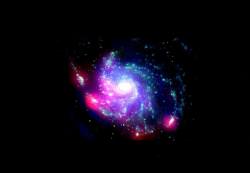A new image taken by the Japanese/European space telescope AKARI turned up huge regions of star formations on the outer edges of galaxy M101. That’s strange. Normally galaxies will have the rapid star formation going on near their centres, and not out at the edges. Astronomers think that it’s all thanks to a recent collision.
M101 is a spiral galaxy in the constellation Ursa Major, and lies about 24 million light-years away. Its diameter is 170,000 light years across, and it has roughly double the mass of the Milky Way. In a galaxy like this, you would expect to see star formation near the middle and along its spiral arms. But in this latest image captured by the AKARI satellite, astronomers have discovered vast regions of star forming regions right out to its outer edges – they’re the bright red blobs in the picture.
It’s not alone out there. Astronomers know that M101 interacted with another galaxy recently, tearing out vast quantities of gas with its gravity. This gas is now falling onto the outer edges of M101, triggering the active star formation. Astronomers have turned AKARI towards several other galaxies nearby, so they hope studying them will help put the puzzle together.
Original Source: JAXA News Release

